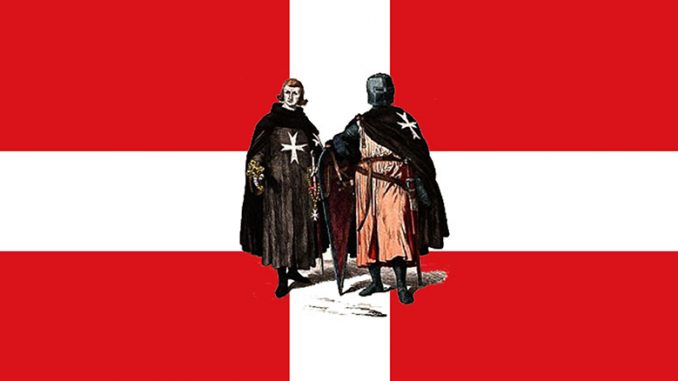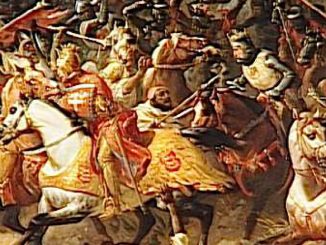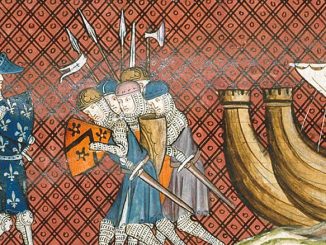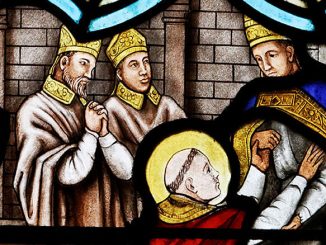
The Knights Hospitaller, known officially as “Knights of the Order of the Hospital of St. John of Jerusalem,” was founded at Jerusalem during the first Crusade. It has been known also as “Knights of Rhodes”, and as the “Sovereign Order of the Knights of Malta.” It was at first a charitable Order, while the Templars was from the first a military one. With the fall of the Latin kingdom of Jerusalem in 1291, the Knights retired to the island of Rhodes. In 1522 the Turks finally took Rhodes, and the Hospitallers removed to Malta. Here they remained till 1793, when Napoleon took Malta, and added it to the French Republic. This ended it as a sovereign power. While the Knights had to leave Malta, shorn of their old power and great wealth, they still continued on in different countries. The Knights took with them from Malta their precious relics–chief among them being the hand of St. John the Baptist, the miraculous image of Our Lady of Pherlemon, and a fragment of the true cross.
Some of the Knights went to Russia and elected the Emperor Paul I Grand Master, and the then Grand Master, Hompesch, resigned in his favor. A chapter of the Knights granted the Pope of Rome authority to name a Grand Master, which he did. When this Grand Master died the head of the Order was called a Lieutenant Grand Master till 1879, when Leo XIII restored the ancient title of Grand Master. The Order of St. Anthony and St. Lazarus were united to the Hospitalers in 1782.
The oldest house of the Order was in France. It is still occupied by the Order. In Italy and Germany it is now called the “Sovereign Order of Malta.” Applicants for knighthood must have sixteen quarterings of nobility and in Austria, before the Great War, also, the consent of the Emperor. The Grand Cross of the Order is a gold white enameled Maltese cross surmounted by a crown. There are two Protestant Orders of St. John of Jerusalem, branches of the parent Order –one in Germany and the other in England. These chapters joined in the Reformation, but for a long time continued their contributions to the head of the Order.
In Prussia members of the Order must be Protestants of noble birth and belong to the Evangelical Church. The Grand Cross there is a Mallese cross of white enameled gold with four black eagles between the arms. Since the Great War the Order has worked for the restoration of the monarchy. In 1924 von Hindenburg officiated at the knighting ceremonies of the Knights of St. John, but after he was elected president of the German Republic he told the Knights that he “resigned his functions.” In 1925 as president of the republic he forbade the former kaiser s son, Eitel Frederick, to officiate at the knighting ceremonies and ordered that they be held in a small chapel at Sonnenberg, instead of in the monarchist church at Potsdam, as usual.
In England the Order was never formally suppressed, and in 1888 Queen Victoria granted it a charter. In 1889 King Edward VII, then Prince of Wales was made Grand Prior. In Great Britain, as in Prussia, the sovereign is the head of the Order, and the heir to the throne Grand Prior. In England it is an aristocratic Order, but not to the extent that it is in Prussia. While members do not have to be Protestants they must believe in Christianity. The Grand Cross in Great Britain is, of course, the gold white enameled Maltese cross, but between the arms are placed two lions and two unicorns.
The first photograph ever taken of a chapter in session appeared in the London Graphic of Sept. 13, 1924. It was one of a meeting of the Priory of Wales at Powis Castle, Welshpool. It shows Knights and Esquires on the steps of the castle in full regalia, including the Right Honorable Lord Kylsant, Sub-Prior for Wales, who deputized for the Prince of Wales, who is Grand Prior.
Grand Masters Of The Knights Hospitaller
1070-1120 – Peter Gerard
1120-1160 – Raymond de Puy
1160-1163 – Auger de Balben
1163-1163 – Arnaud de Comps [Brooke]
1163-1170 – Gilbert d’Assailly Abdicated
1170-1170 – Rostang Rival Grand Master
1170-1172 – Gaston de Murols
1172-1177 – Joubert of Syria
1177-1187 – Roger des Moulins
1187-1188 – William Borrell
1188-1190 – Ermengard d’Asp
1190-1192 – Garnier de Naplous
1190-1201 – Geoffroy de Donjon
1202-1206 – Alphonse de Portugal
1206-1207 – Geoffrey Le Rat
1207-1228 – Garin de Montaigu
1228-1231 – Bertrand de Thessy [Coxi]
1231-1236 – Guerin Brooke
1236-1240 – Bertrand de Comps
1240-1242 – Pierre de Vieille-Bride
1239-1241 – William de Senlis
1242-1258 – Guillaume de Chateauneuf
1244-1250 – John de Ronay
1258-1277 – Hugues de Revel
1278-1284 – Nicolas Lorgne
1284-1294 – Jean de Villiers
1294-1296 – Odon de Pins
1296-1305 – Guillaume de Villaret
1305-1319 – Foulques de Villaret
About Us
We hope you enjoyed this article on ther Knights Hospitaller.
TemplarHistory.com was started in the fall of 1997 by Stephen Dafoe, a Canadian author who has written several books on the Templars and related subjects.
Read more like Knights Hospitaller from our The Crusades Archives – Templar History



